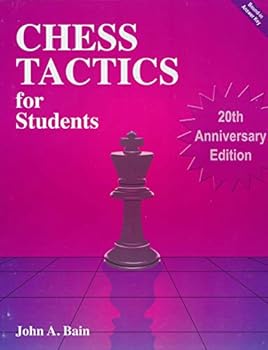Chess Tactics for Students
Select Format
Select Condition 
Book Overview
No Synopsis Available.
Format:Paperback
Language:English
ISBN:0963961403
ISBN13:9780963961402
Release Date:January 1994
Publisher:Learning Plus, Incorporated
Length:252 Pages
Weight:1.41 lbs.
Age Range:7 to 17 years
Grade Range:Grades 2 to 12
Customer Reviews
3 ratings
A great way to start to learn tactics
Published by Thriftbooks.com User , 22 years ago
Just about any chess teacher will tell you that beginners (rating lower than 1600) need to learn three things: tactics, tactics, tactics. Positional knowledge, opening books, and endgame theory won't help you much if you blunder into letting your opponent fork you or if you miss opportunities to do the same.Having said that, this book is a great way to start to practice seeing tactical motiffs (mostly forms of a double attack: pins, forks, skewers, and so on). It is divided into chapters with each chapter focused on a different kind of tactic. After a very brief explanation about what the tactic is, there are a number of exercises in which you have to find the tactic for yourself. There are also hints if you are stuck. I found it helpful to make a little cut-out from some paper to cover the hints and only show the board instead. It is too easy to inadvertently see the hints and ruin the challenge.The book has some very useful advice about how to study: do the first few exercises of each chapter to get an overview of all the tactical motiffs. This will help you start to use and see them in your games. Later, go back and do each chapter thoroughly. Also, chapters are arranged in order of importance; motiffs that occur most frequently are handled first.This book has a couple of limitations. Although it helps you see a tactic, the very nature of an exercise book is that you know one is there. How do you find them in a real game? You have to know when to look for them. There are certain board factors where you are likely to find tactics (an exposed enemy king often means there are great tactical opportunities). This book does nothing to help you realize this. Look at Silman's "Reassess Your Chess" for a very short, but extremely useful discussion of this issue.Also, most of the exercises fall under one of the categories, so you know what kind of tactic to look for, making it easier than a real game situation. The last chapter helps because it is a mix of all tactical motiffs, but there are relatively few of these. Reinfeld's book of 1001 problems is probably a nice supplement in this regard.These are limitations of the book, but not really criticisms. The book does a very good job doing what it is meant to do. The reader should simply realize that there is a bigger picture to look at and supplement accordingly.
A must-read for beginners and casual players.
Published by Thriftbooks.com User , 25 years ago
I feel like a different player after reading this book. A much better player at that. Dont let the title fool you, this book will benifit players of ALL ages including 30-yr old farts like myself.
1300-1700USCF in 2 yrs thx to this and 5 other books
Published by Thriftbooks.com User , 25 years ago
Beginner through 1600. This is one of the BEST books for improving your tactical eye. I like the fact that the author reinforces important ideas by using related problems. The other 5 books are: 1. Chess training pocket book by Alburt. 2. Essential chess endings by Silman. 3. How to reassess your chess by Silman. 4. Chess master at any age by Wetzell. 5. The ideas behind the chess openings by Fine. Start with Bain first then use the other 5 in combination. The KEY is to ANALYSE your OWN GAMES using a computer for tactics and a strong human for positional play. Then store the important positions into chess computer software. Finally, review these positions so that you know them like the back of your hand. Discipline yourself and good luck!





